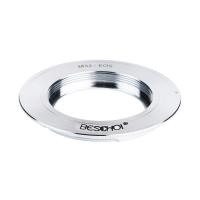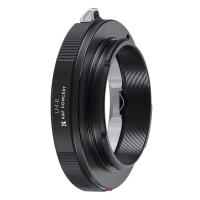How To Calculate Fov Microscope ?
To calculate the field of view (FOV) of a microscope, you need to know the magnification power of the objective lens and the diameter of the field diaphragm. The FOV can be calculated using the following formula:
FOV = (Field Diaphragm Diameter) / (Objective Lens Magnification)
First, measure the diameter of the field diaphragm using a ruler or a calibrated eyepiece graticule. Then, determine the magnification power of the objective lens, which is usually indicated on the lens itself. Divide the diameter of the field diaphragm by the magnification power to obtain the FOV.
It's important to note that the FOV is typically expressed in millimeters or micrometers. Additionally, the FOV may vary depending on the microscope model and the specific objective lens being used.
1、 Numerical Aperture (NA) and Objective Lens Magnification
To calculate the field of view (FOV) of a microscope, you need to consider two main factors: the numerical aperture (NA) and the objective lens magnification.
The numerical aperture is a measure of the light-gathering ability of the lens and determines the resolving power of the microscope. It is calculated using the formula NA = n * sin(θ), where n is the refractive index of the medium between the lens and the specimen, and θ is the half-angle of the cone of light entering the lens. The higher the numerical aperture, the greater the resolving power and the smaller the FOV.
The objective lens magnification refers to the degree of enlargement provided by the lens. It is usually indicated on the lens itself (e.g., 10x, 40x, 100x). The magnification factor determines how much the image is enlarged, but it does not directly affect the FOV.
To calculate the FOV, you need to know the diameter of the field diaphragm or the diameter of the microscope's field of view at a specific magnification. The FOV can be calculated using the formula FOV = (diameter of field diaphragm / objective lens magnification) * 1000. The result is usually expressed in micrometers (µm).
It is important to note that the FOV decreases as the magnification increases. Higher magnifications provide more detailed images but with a smaller FOV. Additionally, the numerical aperture affects the resolution and depth of field, which can also impact the overall quality of the image.
It is worth mentioning that advancements in technology have led to the development of microscopes with larger FOVs and higher numerical apertures, allowing for better imaging capabilities. These improvements have greatly contributed to various scientific fields, such as biology, medicine, and materials science.

2、 Eyepiece Magnification
To calculate the field of view (FOV) of a microscope, you need to consider the eyepiece magnification. The FOV refers to the diameter of the circular area visible through the microscope at a specific magnification. It is an important parameter as it determines the amount of specimen that can be observed at once.
To calculate the FOV, you first need to determine the magnification of the eyepiece. This information is usually provided by the manufacturer and can be found on the eyepiece itself or in the microscope's documentation. Once you have the eyepiece magnification, you can use the following formula:
FOV = (diameter of the field of view of the eyepiece) / (eyepiece magnification)
The diameter of the field of view of the eyepiece can also be provided by the manufacturer or can be measured directly using a ruler or a micrometer. It is important to note that the FOV is typically given in millimeters or micrometers.
It is worth mentioning that the FOV is inversely proportional to the magnification. This means that as the magnification increases, the FOV decreases. Higher magnifications allow for more detailed observations but limit the amount of specimen visible at once.
Additionally, it is important to consider that the FOV can vary between different microscope models and even between different objectives within the same microscope. Therefore, it is always recommended to consult the microscope's documentation or contact the manufacturer for accurate information on FOV calculations.

3、 Field Number and Field Diameter
To calculate the field of view (FOV) of a microscope, you need to know the field number and field diameter. The field number is a constant value specific to each microscope objective, while the field diameter is the actual diameter of the field of view observed through the microscope.
To calculate the FOV, you can use the following formula:
FOV = (Field Diameter / Field Number) x 1000
The field number is usually engraved on the microscope objective and represents the diameter of the field of view in millimeters. The field diameter is the actual diameter of the circular area visible when looking through the microscope.
For example, if the field number is 18 and the field diameter is 0.5 mm, the FOV can be calculated as follows:
FOV = (0.5 mm / 18) x 1000 = 27.78 mm
This means that the field of view observed through the microscope is approximately 27.78 mm.
It is important to note that the FOV may vary depending on the magnification of the objective being used. Higher magnification objectives typically have smaller field diameters and therefore a narrower FOV. Additionally, different microscope models may have different field numbers, so it is essential to refer to the specific microscope's documentation or consult the manufacturer for accurate calculations.
Calculating the FOV is crucial for various applications, such as measuring the size of microscopic objects or estimating the distance traveled by microorganisms. It allows researchers and scientists to accurately interpret and analyze the microscopic images obtained through the microscope.

4、 Calculating Field of View (FOV) Diameter
To calculate the field of view (FOV) diameter of a microscope, you need to know the magnification power and the diameter of the field diaphragm. The FOV diameter refers to the width of the area visible through the microscope.
Here's how you can calculate the FOV diameter:
1. Determine the magnification power: Look at the eyepiece of the microscope and find the magnification value. It is usually written as a number followed by "X" (e.g., 10X, 40X, 100X).
2. Measure the diameter of the field diaphragm: The field diaphragm is a circular opening located in the microscope's condenser. Use a ruler or a caliper to measure the diameter of this opening in millimeters.
3. Calculate the FOV diameter: Divide the diameter of the field diaphragm by the magnification power. This will give you the FOV diameter in millimeters.
For example, if the magnification power is 40X and the diameter of the field diaphragm is 2 millimeters, the FOV diameter would be 2/40 = 0.05 millimeters.
It's important to note that the FOV diameter will vary depending on the magnification power and the microscope model. Higher magnification powers generally result in smaller FOV diameters, while lower magnification powers provide larger FOV diameters.
Additionally, it's worth mentioning that some microscopes have adjustable field diaphragms, allowing you to change the diameter and consequently the FOV diameter.









































